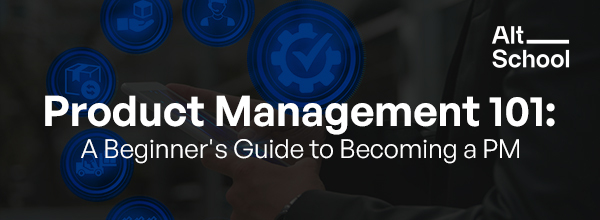
22 Jul 2025 Product Management 101: A Beginner’s Guide to Becoming a PM
Have you ever used an app or a service that just… works? That feels intuitive, solves a real problem, and maybe even brings a little joy to your day? Think of a seamless online banking experience, a game that keeps you hooked, or a streaming service that always knows what you want to watch next. Behind every one of those delightful digital (or even physical) products, there’s a dedicated group of individuals making it happen, led by a crucial role: the Product Manager.
Just like you who have spent years in customer support, constantly hearing user frustrations and ideas for improvement. You love helping people, but you yearn to be on the creation side, to build solutions rather than just troubleshoot them. The more you listen, the more you find yourself thinking: “If only we could add this feature,” or “What if we reimagined that process?” That curiosity, that desire to bridge the gap between user pain and innovative solutions, can be the first spark to your journey into Product Management. If you’re driven by curiosity, enjoy problem-solving, and have a knack for bringing diverse teams together, then the world of Product Management might just be waiting for you.
But what exactly is Product Management? It’s often described as the intersection of business, technology, and user experience. Think of a Product Manager (PM) as the “mini-CEO” of a product. They don’t manage people, but they manage the product, guiding its vision, strategy, design, and execution from inception to launch and beyond. They are the voice of the user, the champion of the business, and the trusted partner of the engineering team, all rolled into one dynamic role.
Let’s unpack the core responsibilities and essential skills that define this exciting profession, and discover how you can begin your own journey with readily available, free resources.
The Core Mission of a Product Manager
A Product Manager’s day is rarely the same, but their overarching mission remains constant: to identify significant user problems and market opportunities, define solutions that create value for both the user and the business, and lead a cross-functional team to deliver and iterate on those solutions. This mission breaks down into several key pillars:
- Deep User & Market Understanding (Discovery): This is the bedrock. A PM is a relentless detective, constantly seeking to understand customer needs, pain points, desires, and behaviors. They immerse themselves in market trends, competitor analysis, and emerging technologies. This isn’t guesswork; it’s systematic research.
In Action: You spend your mornings analyzing user feedback forums, conducting user interviews, and pouring over market research reports to uncover unmet needs for her new educational app.
- Strategic Vision & Product Definition: With a clear understanding of the “problem space,” the PM crafts a compelling product vision – the long-term aspirational goal of the product. They then translate this vision into a clear, actionable product strategy, defining what will be built, why it matters, and how it aligns with business objectives.
In Action: After discovering a key user struggle, you define a clear vision for a new “interactive learning module” within the app, outlining its purpose and how it will elevate the user experience.
- Prioritization & Roadmapping: In a world of infinite possibilities but finite resources, a PM becomes the chief prioritizer. They decide what features to build, what to defer, and what to discard, based on a rigorous assessment of user value, business impact, and technical feasibility. The product roadmap is their communication tool for this plan.
In Action: You debate with the engineering team: should they build the “quiz feature” or “gamified badges” first? You use data on user engagement and projected development effort to make a data-driven decision.
- Execution & Cross-Functional Collaboration: The PM is the central hub, facilitating communication and alignment across diverse teams: engineering, design, marketing, sales, and customer support. They clarify requirements, resolve ambiguities, remove roadblocks, and ensure everyone is marching to the beat of the same product drum.
In Action: You hold daily stand-ups with the development team, reviews design mock-ups with the UX designer, and briefs the marketing team on upcoming feature launches.
- Measurement, Learning & Iteration: Launching a product is merely the beginning. A PM relentlessly tracks key performance indicators (KPIs), gathers user feedback through various channels, and analyzes data to understand how the product is performing against its goals. This continuous learning informs subsequent improvements and iterations, ensuring the product evolves and stays relevant.
In Action: Post-launch, you meticulously track user engagement with the new module. If users drop off at a certain point, she initiates A/B tests to understand why and proposes improvements for the next iteration.
Key Skills You’ll Need to Cultivate (And How to Think About Them)
Becoming a successful Product Manager isn’t about being a master of every single skill, but rather a jack-of-all-trades with a deep understanding of core principles. Here are the essential skills to cultivate:
- User Research & Empathy:
What it means: The ability to step into your users’ shoes, truly understanding their problems, motivations, and unmet needs. This involves conducting interviews, surveys, usability tests, and observing user behavior.
Why it’s crucial: Without empathy, you’re building in the dark. A PM is the unwavering advocate for the user. Nielsen Norman Group is a leading resource for user experience (UX) and usability research, offering extensive free articles on best practices.
- Prioritization & Strategic Thinking:
What it means: The art of saying “no” to good ideas to focus on the best ideas. It involves evaluating opportunities based on user value, business impact, and technical feasibility, aligning product efforts with the company’s overarching vision.
Why it’s crucial: Resources (time, money, engineering talent) are always limited. A PM’s ability to prioritize effectively ensures the team builds the right things at the right time.
- Communication & Stakeholder Management:
What it means: The ability to articulate complex ideas clearly and concisely, adapting your message for different audiences (engineers, designers, sales, executives, users). It’s also about managing expectations, resolving conflicts, and building consensus across diverse teams.
Why it’s crucial: PMs are the central communication hub. They need to ensure everyone from the CEO to the customer support team understands the product’s direction and purpose.
- Data Analysis & Experimentation:
What it means: The comfort with numbers and the ability to interpret data (e.g., user engagement metrics, conversion rates, market trends) to inform decisions and validate hypotheses. It also involves designing and analyzing A/B tests.
Why it’s crucial: Data provides objective insights, moving decisions from “I think” to “I know.” It allows PMs to measure success and identify areas for improvement. Google Analytics is a free tool often used for website and app data analysis.
- Technical Acumen (Understanding, Not Coding):
What it means: Not being a software engineer, but having a fundamental understanding of how software is built, the technologies involved, and the implications of technical decisions. This helps in realistic planning and effective communication with development teams.
Why it’s crucial: A PM needs to speak the language of engineering to build trust, understand limitations, and collaboratively find efficient solutions. Think of it like a conductor understanding the instruments without playing every one.
Free Tools to Kickstart Your Product Management Practice
You don’t need a fancy budget to start practicing Product Management. Many powerful tools offer free tiers perfect for beginners to build foundational skills and simulate real-world scenarios:
- For Brainstorming & Visual Collaboration (Virtual Whiteboards):
1. Miro: An incredibly versatile online whiteboard. Use it for user journey mapping, brainstorming sessions, creating flowcharts, and even simple wireframing. The free tier offers plenty of features for individual or small project use.
2. Figma Community Files: While Figma is primarily a UI/UX design tool, its collaborative nature means you can use it for sketching out user flows, creating simple mockups, or even finding pre-made templates for roadmaps. Their free tier is robust.
- For Project & Task Management (Kanban Boards):
1. Trello: Simple, intuitive, and highly visual. Perfect for organizing tasks, managing a personal “product backlog,” or simulating a development sprint with a Kanban board. The free version is excellent.
2. Asana: A more robust project management tool with a good free tier for smaller teams or individual use. Great for learning how to break down projects, assign tasks, and track progress.
- For Documentation & Knowledge Management (PRDs, User Stories):
- Notion: An all-in-one workspace that’s incredibly flexible. You can use it to draft Product Requirement Documents (PRDs), write user stories, create knowledge bases, and manage notes. Its free personal plan is very generous.
- Google Workspace (Docs, Sheets, Slides): Simple, collaborative, and universally accessible. Perfect for writing early PRDs, tracking user feedback in spreadsheets, or creating simple presentations for stakeholders.
- For User Feedback & Surveys:
- Google Forms: A free and easy-to-use tool for creating surveys to gather user feedback, test hypotheses, and conduct simple market research.
- Typeform: Offers a more engaging and visually appealing way to create surveys and forms, with a free basic plan that’s great for qualitative feedback gathering.
Where to Learn More (Free Resources That Actually Help!)
The Product Management community is incredibly generous with knowledge. Dive into these excellent, free resources to deepen your understanding:
- Online Courses & Certifications:
- AltSchool Africa: Offer a 12 month diploma course covering various PM topics.
- Influential Blogs & Newsletters:
- Lenny’s Newsletter: A highly respected weekly newsletter covering product, growth, and career insights, often with in-depth interviews.
- Product Talk by Teresa Torres: Focuses specifically on “continuous discovery” – how to continuously learn about user needs. Essential reading for aspiring PMs.
- SVPG (Silicon Valley Product Group) by Marty Cagan: Classic and foundational articles on building successful products from a veteran PM.
- Mind the Product Blog: A vast collection of articles and resources from a global community of product people.
- Podcasts (Listen on your commute!):
- “Product School Podcast”: Interviews with leading product executives.
- “Rocketship.fm”: Covers various startup and product topics.
- “This is Product Management” by Alpha UX: Another great resource for diverse PM perspectives. (Search on your favorite podcast platform like Spotify or Apple Podcasts.
Product Management is a challenging, multifaceted, and incredibly rewarding career. It’s about being a problem solver, a visionary, and a collaborator. It’s about building things that truly impact people’s lives. You can start by simply asking “why?” and then begin to explore the fascinating journey of bringing innovative products to the world. Your product journey starts now.


Sorry, the comment form is closed at this time.